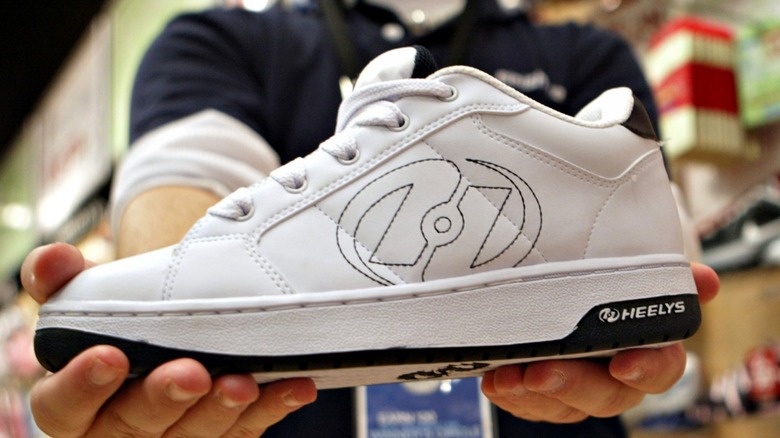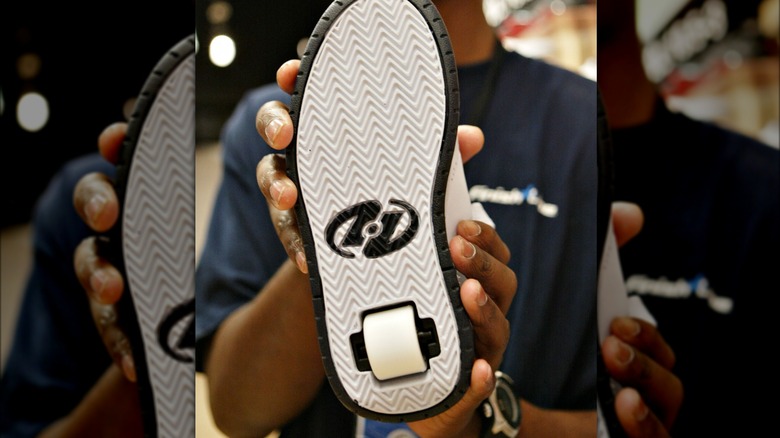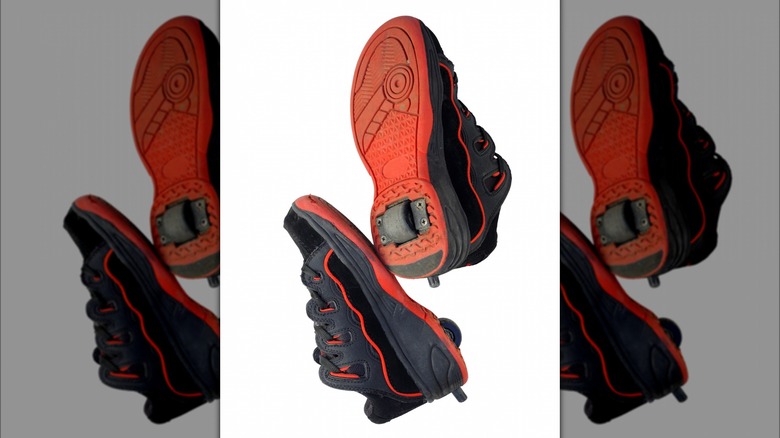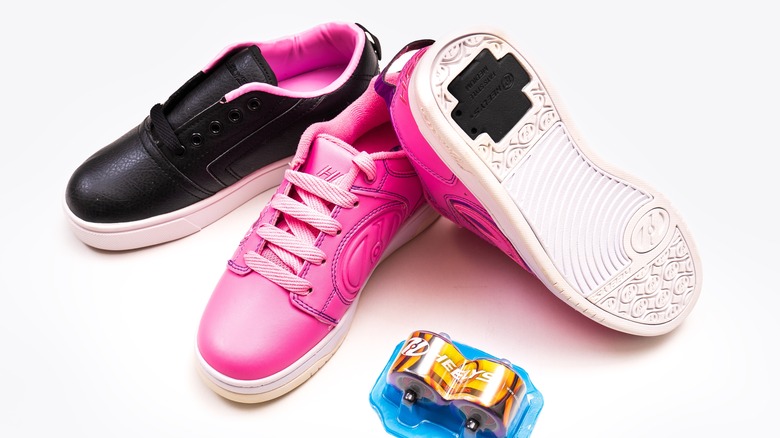Whatever Happened To Heelys?
In the mid-2000s, Heelys — a sneaker with a removable wheel in the heel — were seemingly everywhere, as teens, tweens, and young adults in particular rolled their way around towns, malls, and schools. As a result, Heelys' corporate parent, Heeling Sports Limited (HSL), enjoyed strong profits for years. But as quickly as Heelys emerged, by 2009, safety concerns and corporate disagreement contributed to a slump in sales for what was then a must-have novelty item. For a time it seemed that kids on wheels, often indoors with other people around, wasn't such a good idea after all.
Accordingly, in the 2010s, HSL, now Texas-based Heelys Inc., underwent several ownership changes and behind-the-scenes corporate reshuffling. The shoes, however, never completely went away. As of 2023, they're available in stores and online from Heelys.com, among other retailers. Meanwhile, Heelys are still promoted in the college market by campus ambassadors. From the origin of the Heelys idea to a founder who effectively quit while ahead, here's what happened to the once beloved and ubiquitous footwear you might remember from childhood.
The origin of the idea and the first prototype
In 1998, Heelys founder Roger Adams, recently divorced and somewhat lost in life, was in Huntington Beach, California when the idea for a roller skate-sneaker combo struck him. Years later, Adams told NBC News, "I was on vacation at Huntington Beach in 1998, going through the proverbial bachelor-house-on-the-beach phase, watching kids going up and down the beach on their online skates, and it reminded me of a happier time in my life. I had an idea of a shoe that could roll on command by just shifting your body weight. It was like a flash; the hair stood up on the back of my neck."
Around that same time, Adams, who learned to roller skate at 9 months old, constructed the first Heelys prototype, carving space for the wheel in an old pair of Nikes. And like many product origin stories, he tinkered with the idea in a friend's garage. By the year 2000, Adams had founded Heeling Sports Limited, and after several stops and starts, Capital Southwest Corporation, a venture capital company, got involved. With funding secured, Adams became president of Heeling Sports Limited, and experienced businessman Michael Staffaroni was brought in — first as a consultant and then, in 2001, as CEO.
At first, Heelys — marketed as "stealth skates" — were primarily pitched at trade shows. By Christmas 2000, overwhelming interest brought the product to retail much faster. Those involved expected $12 million in sales in the first year. As Staffaroni later told Mel Magazine, "I realized the thing had some legs, and the response from the consumer and retailers were good."
A swift ascent
In the year 2000, Heelys distribution was somewhat limited, but in 2001, a Heelys ad premiered on MTV in select markets, Adweek reported that year. The tagline? "Freedom is a wheel in your sole." Also in 2001, WIRED called Heelys "the next step in personal mobility." The next year, exposure was heightened: Heelys appeared in the family movie "Spy Kids 2" worn by the character Juni Cortez, and pop singer Usher wore a pair in his 2002 music video "U Don't Have to Call." By 2004, HSL had purchased other companies and diversified its product offerings, while Heelys marketing broadened beyond just young boys. Meanwhile, Heelys' retail presence grew worldwide. That year, the brand was available in 50 countries — and was particularly popular in Asia, where the shoes were also made.
Promoting "heeling" as a sport helped expand the product's appeal. Reuters reported Heelys sales doubled between 2004 and 2005 thanks in no small part to viral marketing, reaching $44 million. By 2006, Heelys sales were reportedly up more than 300%. Around that same time, HSL went public, and profits seemed limitless.
Despite all that, cracks in the firmament were forming. The company had a significant amount of debt, and in 2007, senior analyst at New York-based Susquehanna Financial John Shanley told Reuters, "The real issue for investors is sustainability. When a product like [Heelys] falls out of favor, there is no bottom to it. To grow, a company needs to find additional products to sell."
Heelys tumble
Back in 2001, WIRED seemed to predict the future when it wrote: "[Heelys were] destined to infuriate strip mall security guards," and in the event of an accident, they would instill horror in "anyone legally liable." For similar reasons, by 2006, CBS News reported Heelys were banned in many schools and malls, and parents and doctors were increasingly concerned about accidents.
One parent, Valerie Poston, whose daughter suffered a concussion in a Heelys fall, told CBS News, "It just didn't dawn on me that they were so dangerous." Dr. Steven Krug of Chicago Children's Memorial Hospital predicted that as Heely sales boomed, "[W]e will see more injuries in our emergency departments." Those safety concerns were supported by studies published in the journal Pediatrics, ABC News reported the next year.
In response, Heelys Inc. quoted Consumer Product Safety Commission data, affirming the product was safer than other common childhood activities like bicycle riding and several sports. Defending the brand's safety record, then-Heelys Inc. CEO Mike Staffaroni said in a press release (via Chron), "When Heelys are used in accordance with safety instructions we provide in our packaging and on our Web site (with the proper safety equipment), wheeled sports provide safe opportunities for children to exercise." Around that same time, Heelys founder Roger Adams cashed in $26.3 million in stocks and effectively left the company.
Internal discord and brand sale
It was more than just safety issues that brought Heelys footwear down to earth. There was also disagreement within the company. As Michael Staffaroni told Mel Magazine, "It started to become clear in 2007 that selling 5 to 6 million pairs of wheeled shoes in the U.S. every year isn't sustainable, because kids aren't coming back for a second pair. Still, we were getting really strong brand recognition as we sold more pairs, so the only way to grow was acquiring smaller companies, expanding internationally and stretching the brand to sell stuff that wasn't just shoes with wheels."
Staffaroni added, "[The board would say] 'Why wouldn't we just keep selling them? We're making a lot of money!' In hindsight I wish we'd done a better job and a more focused effort at building the brand and not allowing it to become just an item." The board rejected Skechers' offer to buy Heelys for $142.8 million — Heelys felt undervalued, per Reuters. But around that same time, the company's stock value plummeted, and no one knew how low it might go. Meanwhile, Roger Adams cashed out his remaining stock holdings, finalizing his exit, and both he and Staffaroni left the company.
Footwear News says in 2013, Sequential Brands Group bought Heelys Inc. and licensed the brand to BBC International, which overhauled the footwear line. In 2014, Footwear News reported increased sales for retailers selling Heelys — notably, Zappos.com had its best year ever selling the brand. "[W[e believe we can take Heelys to the next level," then-BBC Chairman and CEO Bob Campbell said. In 2021, Sequential sold Heelys outright to BBC International for $11 million.
Heelys roll on
That turmoil aside, Heelys remain in production and are still sold through both online and major brick-and-mortar retailers. They are available for both men and women and for all ages in different designs and styles. There's also now a line of accessories, and the brand maintains a presence on Instagram and Twitter. On August 30, 2023, @morganisawizard tweeted, "Just saw a girl wearing heelys. We are so back." And on August 31, 2023, Heelys posted a meme on Instagram that read in part, "If the store is against Heelys, I am not going inside." In response, overland_by_ebay commented, "Every store that has said 'you can't use those here,' I leave and do not come back."
Speaking with NBC News back in 2004, Roger Adams summed up his success, unaware of the tough road ahead. "There's a magic to believing in something," he said. "Follow your dreams and roll the dice. There are plenty of doors that are shut; find a way to open one. If I'd listened to the many people saying, 'No, you can't do this,' I'd have never gotten off square one." On Adams, Staffaroni later commented in 2020 (via MEL Magazine), "[L]ast I heard, he's managing the patent and noodling around with some other ideas, living happily ever after out in Lake Tahoe. He's got a lot of dough, that's for sure."



